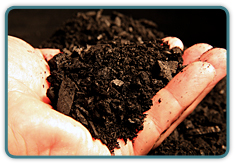- Biochar
- Vitrified Glass
- Chemical Compounds
 Biochar, a charcoal-based soil amendment produced by pyrolysis of waste biomass, is a phenomenal soil conditioner.
Biochar, a charcoal-based soil amendment produced by pyrolysis of waste biomass, is a phenomenal soil conditioner.
Home / Biomass and Biochar
Byproduct: Biochar
Agricultural, as well as animal waste, such as chicken manure, are a great source of energy!
Although “composting” is an environmentally friendly practice, it is very inefficient and Green House Gases are released into the atmosphere. When compost is used as fertilizer, this material can take months to become available to the plants and some of the nutrients in this compost are affected by climate conditions.
Using WES International's proprietary technology,
Using “Fast Pyrolysis”, organic waste such as chicken manure, rice husk, sugar cane bagasse and others, can easily be converted into biofuels and biochar based fertilizers.
According to the International Biochar Initiative, Biochar is found in soils around the world as a result of vegetation fires and historic soil management practices. Intensive studies of rich dark soils in the Amazon called “terra preta” has led to a great appreciation of the properties of this unique material as a soil conditioner.
Although “composting” is an environmentally friendly practice, it is very inefficient and Green House Gases are released into the atmosphere. When compost is used as fertilizer, this material can take months to become available to the plants and some of the nutrients in this compost are affected by climate conditions.
Using WES International's proprietary technology,
it is possible to transform all types of biomass into electricity and biofuels.
Using “Fast Pyrolysis”, organic waste such as chicken manure, rice husk, sugar cane bagasse and others, can easily be converted into biofuels and biochar based fertilizers.
Biochar ... a fast pyrolosis byproduct
Biochar is a charcoal-based soil amendment produced by pyrolysis of waste biomass. This material presents a fine-grained, highly porous structure that helps soils retain water and nutrients.According to the International Biochar Initiative, Biochar is found in soils around the world as a result of vegetation fires and historic soil management practices. Intensive studies of rich dark soils in the Amazon called “terra preta” has led to a great appreciation of the properties of this unique material as a soil conditioner.
Due to the porous texture, biochar offers the following agronomic benefits:
- Increases water retention reducing irrigation rates
- Increases the number of beneficial soil microbes
- Moderates soil acidity
- Reduces leaching of nitrogen into ground water
- Improves cation-exchange capacity